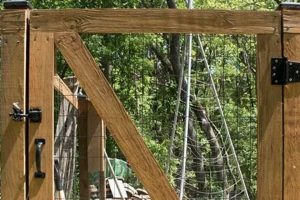The assembly and installation of a safety support system along a staircase, undertaken by a homeowner or non-professional, constitutes a do-it-yourself project focused on enhanced accessibility and safety. This typically involves selecting materials such as wood, metal, or composite materials, measuring the staircase dimensions, cutting and shaping the chosen material, and securing it to the wall or staircase structure. An example is a homeowner constructing and mounting a wooden support to aid in ascending and descending stairs.
The provision of such a structure offers several advantages. It increases safety, especially for individuals with mobility challenges, and can add aesthetic value to a home’s interior. Historically, the creation and fitting of these structures were the domain of skilled carpenters; however, the availability of prefabricated components and readily accessible instructions has made it increasingly feasible for individuals to undertake the work independently. This accessibility fosters cost savings and allows for personalization to match specific design preferences.
The subsequent sections will delve into critical aspects of this endeavor, encompassing planning considerations, material selection criteria, installation techniques, and essential safety precautions. Comprehensive knowledge in these areas is crucial for ensuring a successful and structurally sound finished product.
DIY Stair Handrail Tips
Effective planning and execution are paramount for a successful self-installed stair support. Consider these guidelines to ensure structural integrity, safety compliance, and aesthetic appeal.
Tip 1: Accurate Measurement is Essential: Begin with precise measurements of the staircase’s length, rise, and run. Inaccurate measurements will lead to improperly sized components and potential safety hazards. Use a level and measuring tape to determine the correct angles and distances.
Tip 2: Select Durable and Compliant Materials: Choose materials that meet or exceed local building codes for strength and fire resistance. Pressure-treated lumber, solid hardwoods, and powder-coated steel are common choices. Verify code requirements related to graspability and height.
Tip 3: Prioritize Secure Mounting: Ensure the support is firmly anchored to the wall studs or staircase frame. Use appropriate fasteners, such as lag screws or expansion bolts, and avoid relying solely on drywall anchors. Inspect the mounting hardware regularly for tightness.
Tip 4: Maintain Consistent Height: Install the support at a consistent height along the entire staircase. This ensures comfortable and safe use for all individuals. Typically, the top of the support should be between 34 and 38 inches above the stair treads.
Tip 5: Smooth Surfaces Are Critical: Sand and finish all surfaces to eliminate splinters and rough edges. Apply a durable, non-slip coating to provide a secure grip. Consider the use of handrail brackets to create a smooth, continuous surface.
Tip 6: Adhere to Building Codes: Research and comply with all applicable local building codes related to staircase construction and safety features. These codes may specify requirements for spacing, height, and load-bearing capacity.
Tip 7: Use Proper Tools and Safety Gear: Employ the appropriate tools for cutting, drilling, and fastening materials. Wear safety glasses, gloves, and a dust mask to protect against injury. Ensure the work area is well-ventilated.
Careful attention to detail during each phase of the installation process will result in a stable, functional, and aesthetically pleasing addition to the staircase. Prioritizing safety and code compliance is crucial for protecting users and ensuring long-term structural integrity.
The subsequent sections will explore common challenges encountered during installation and offer solutions for overcoming these obstacles.
1. Material Strength
The integrity of a self-installed staircase support is fundamentally dependent upon the strength of the constituent materials. Insufficient material strength directly compromises the handrail’s ability to provide adequate support, potentially leading to structural failure and subsequent injury. Material selection must consider the anticipated load-bearing requirements, which include the weight of individuals using the staircase, as well as any potential impact forces. A homeowner’s choice of low-density wood for a handrail, for example, may prove inadequate if the handrail is subjected to significant weight or stress, increasing the risk of collapse. Conversely, the selection of high-strength steel or hardwoods offers a greater margin of safety and improved long-term durability.
Building codes often specify minimum strength requirements for staircase supports, reflecting the critical role material strength plays in ensuring safety. These codes may dictate the allowable deflection under load, the required tensile strength of fasteners, and the permissible species of wood for construction. Failure to adhere to these standards not only increases the risk of accidents but also may result in legal liabilities in the event of injury. The practical application of this understanding necessitates careful assessment of material properties, including density, bending strength, and resistance to weathering. Furthermore, consideration should be given to the long-term effects of moisture, temperature variations, and potential insect infestation on material degradation.
Ultimately, the choice of materials dictates the performance and longevity of the finished stair support. A thorough understanding of material strength characteristics, coupled with adherence to building codes and best practices, is crucial for mitigating risks and ensuring the safety of individuals using the staircase. Ignoring these principles can result in a structurally unsound handrail, leading to potential hazards and compromising the overall safety of the home. The selection of appropriate materials is therefore a foundational element of any successful self-installed staircase support project.
2. Secure Anchoring
Secure anchoring represents a critical element in the successful implementation of a self-installed stair support system. This process ensures the handrail remains firmly affixed to the supporting structure, preventing movement and ensuring stability for users. Inadequate anchoring compromises the structural integrity of the entire system, posing a significant safety risk.
- Fastener Selection
The selection of appropriate fasteners, such as lag screws, expansion bolts, or specialized heavy-duty anchors, is paramount. The chosen fastener must possess sufficient load-bearing capacity to withstand the anticipated forces exerted on the handrail. The material of the wall or staircase frame dictates the optimal fastener type; concrete requires different anchoring soluti
ons compared to wood framing. An instance of improper fastener selection involves utilizing drywall screws to secure a wood handrail to a drywall-covered wall, where the screws are prone to pull out under minimal stress. - Stud and Joist Location
Whenever feasible, anchoring should target structural members such as wall studs or staircase stringers. Locating these members and securing the handrail directly to them provides a significantly stronger connection compared to anchoring solely to drywall or plaster. Stud finders and careful measurement can help identify the precise location of these load-bearing elements. An instance where stud location is crucial is when installing a handrail along a wall that is not directly against a wall stud. Attaching directly to the stud ensures stability and support for the handrail.
- Proper Installation Techniques
The correct installation technique is essential to maximize the effectiveness of any fastener. This includes pre-drilling pilot holes of the appropriate size, ensuring proper alignment, and applying the correct torque to the fasteners. Overtightening can strip threads and weaken the connection, while under-tightening leaves the fastener loose and ineffective. For example, using an impact driver at the wrong torque setting can easily strip the screw heads if the torque is too high, or it can be installed improperly where torque is too low. Proper technique requires careful execution for reliable security.
- Load Testing and Inspection
Following installation, the security of the anchoring system should be thoroughly tested. Applying a moderate amount of force to the handrail and observing any movement or deflection can help identify potential weaknesses. Regular inspections of the fasteners and anchoring points are necessary to detect signs of loosening or corrosion. An example is that if the handrail shakes upon physical push, it is a sign of loose or improper anchoring. Regular checkups and occasional tightening of the fasteners are essential for maintaining a stable system.
In summary, secure anchoring is the cornerstone of a safe and reliable self-installed stair support system. Paying meticulous attention to fastener selection, stud location, installation techniques, and subsequent inspection ensures the handrail effectively fulfills its intended purpose: providing stable support for individuals using the staircase.
3. Consistent Height
The adherence to a consistent height is a critical safety parameter in the installation of a do-it-yourself stair handrail. Deviations from a uniform height present a trip hazard and can impede the ability of users, particularly those with mobility limitations, to maintain balance and stability while ascending or descending stairs. An inconsistent handrail height disrupts the expected rhythm of support, increasing the risk of falls. For instance, a handrail that varies in height by even a few inches along its length can cause a user to stumble as they adjust their grip unexpectedly. This is especially dangerous for elderly individuals or those with visual impairments.
Building codes and accessibility guidelines typically specify a mandated height range for stair handrails, usually between 34 and 38 inches measured vertically from the stair tread nosing. This standardized height range is intended to accommodate a broad spectrum of user heights and ensure ergonomic suitability. When constructing a handrail, accurate measurements and careful installation are crucial to maintaining this consistency. This may involve utilizing shims or adjusting mounting brackets to compensate for uneven wall surfaces or minor variations in stair tread heights. A practical example includes using a laser level to establish a consistent horizontal line along the staircase wall, serving as a visual guide during the handrail installation process.
Maintaining a consistent handrail height along the entire staircase length ensures a safer and more user-friendly environment. Failure to adhere to these height standards introduces a potential safety hazard and may render the staircase non-compliant with applicable building regulations. Consequently, meticulous attention to detail and a commitment to accurate measurements are essential components of any successful handrail project. This systematic approach significantly mitigates risks and fosters greater peace of mind for homeowners and their families.
4. Smooth Surfaces
The characteristic of smooth surfaces in a self-constructed staircase support directly influences user safety and comfort. A rough or uneven surface presents a tangible hazard, increasing the likelihood of splinters, abrasions, and compromised grip. The absence of a smooth surface negates a primary function of the handrail: to provide a secure and reliable aid for ascending and descending stairs. A real-world example includes a wooden handrail left unfinished, its splinter-prone surface rendering it unusable without risking injury. Conversely, a properly sanded and finished handrail offers a secure and comfortable grip, thereby reducing the risk of falls.
Achieving a smooth surface involves multiple steps, encompassing material selection, sanding techniques, and appropriate finishing applications. The choice of wood or metal directly impacts the effort required to achieve smoothness. Hardwoods, while durable, may necessitate more extensive sanding than softer woods. Sanding involves progressive reduction of surface imperfections, typically using successively finer grits of sandpaper. Proper technique, including sanding with the grain and avoiding excessive pressure, prevents further damage. The application of a protective finish, such as varnish or polyurethane, seals the surface, enhancing its smoothness and preventing splintering. This process significantly contributes to the tactile quality of the support.
In summation, the attainment of smooth surfaces on a staircase support is not merely an aesthetic consideration; it represents a fundamental aspect of user safety. A smooth, well-finished surface provides a comfortable and secure grip, thereby reducing the risk of falls and enhancing the overall usability of the staircase. Neglecting this critical detail undermines the handrail’s effectiveness and can result in preventable injuries. Adhering to best practices in sanding and finishing is, therefore, essential for any homeowner undertaking a stair support installation project.
5. Code Compliance
Code compliance forms an integral and non-negotiable component of any self-installed stair support. Building codes, developed and enforced by local municipalities, establish minimum safety standards for construction, including specific requirements for staircase dimensions, handrail height, graspability, and load-bearing capacity. Disregarding these codes can result in a structure that poses significant safety hazards, exposes homeowners to legal liability, and may necessitate costly remediation to achieve compliance. The cause-and-effect relationship is direct: non-compliance results in an unsafe structure; adherence results in a safer, code-approved installation. For instance, a support installed at an improper height not only increases the risk of
falls but also fails to meet code requirements, potentially leading to rejection during inspection.
The practical significance of understanding code compliance resides in the prevention of accidents and the assurance of structural integrity. Specific code provisions often dictate the type of materials permissible for handrail construction, the spacing between balusters, and the manner in which the support must be anchored to the wall or staircase frame. Failing to adhere to these specifications can lead to structural weaknesses, increased fire risks, and difficulties in obtaining necessary permits or approvals. An example is the common requirement for a continuous, graspable handrail profile, enabling users to maintain a secure grip throughout their ascent or descent. This specific element directly addresses user safety and reduces the likelihood of falls.
In conclusion, code compliance is not merely a bureaucratic formality; it is a fundamental aspect of responsible construction practice. Adhering to local building codes ensures that the constructed staircase support provides a safe and reliable means of navigating the staircase, minimizing the risk of accidents and safeguarding the well-being of occupants. While undertaking a do-it-yourself project offers cost savings and customization opportunities, neglecting code compliance can negate these benefits and create potentially dangerous conditions. Therefore, thorough research and adherence to all applicable codes are essential prerequisites for any self-installed stair support endeavor.
Frequently Asked Questions
The following represents a compilation of commonly encountered inquiries regarding the self-installation of staircase supports. The information provided aims to address key considerations and potential concerns.
Question 1: What are the essential tools required for a successful stair handrail installation?
The assembly and mounting of a stair support system necessitate a range of tools. A measuring tape ensures accurate dimensions. A level guarantees horizontal and vertical alignment. A stud finder locates framing members for secure attachment. A drill with various bits facilitates pilot hole creation and fastener installation. A saw, either manual or powered, enables precise cutting of materials. Safety glasses and gloves provide essential protection. Additional tools, such as a chisel, sandpaper, and a finishing applicator, may be required depending on the chosen materials and finishing techniques.
Question 2: What are the primary safety considerations during a stair handrail installation?
Safety protocols are paramount throughout the installation process. Eye protection shields against debris. Gloves protect hands from splinters and abrasions. A dust mask mitigates inhalation of particulate matter generated during cutting and sanding. The work area should be well-ventilated to prevent the accumulation of harmful fumes from finishes. Power tools should be used in accordance with manufacturer instructions, with appropriate safety guards in place. Secure footing and proper ladder placement are essential to prevent falls. Adherence to all relevant building codes is non-negotiable.
Question 3: How does one determine the appropriate height for a stair handrail?
Building codes typically mandate a height range for stair supports, generally between 34 and 38 inches, measured vertically from the stair tread nosing to the top of the handrail. This range aims to accommodate a broad spectrum of users and ensure ergonomic suitability. Precise measurement and consistent application of this height standard are critical for maximizing safety and accessibility.
Question 4: What are the common challenges encountered during stair handrail installation, and how can they be overcome?
Frequently encountered challenges include uneven wall surfaces, misaligned stair treads, and difficulty locating wall studs. Uneven wall surfaces can be addressed through the use of shims or adjustable mounting brackets. Misaligned stair treads may necessitate minor adjustments to the handrail mounting positions. A reliable stud finder and careful measurement techniques facilitate accurate stud location. Patience, precision, and a willingness to adapt to unforeseen circumstances are essential for overcoming these challenges.
Question 5: How should one select the appropriate materials for a stair handrail, considering both aesthetics and durability?
Material selection should consider both the desired aesthetic appearance and the required structural integrity. Hardwoods, such as oak and maple, offer durability and visual appeal. Metal supports provide strength and a contemporary aesthetic. Composite materials offer resistance to moisture and insect damage. The chosen material should comply with building code requirements for fire resistance and load-bearing capacity. A balance between aesthetic preferences and practical considerations is essential for a successful outcome.
Question 6: What are the legal ramifications of installing a stair handrail that does not comply with local building codes?
Installing a staircase support that fails to comply with local building codes can result in a range of legal consequences. Municipal authorities may issue violation notices, requiring corrective action. Failure to comply with these notices can result in fines or even legal action. In the event of an accident or injury resulting from a non-compliant installation, the homeowner may be held liable for damages. Compliance with building codes is not merely a suggestion; it is a legal obligation with potentially significant consequences.
Accurate planning, careful execution, and adherence to established guidelines are paramount for ensuring a safe and code-compliant staircase support installation.
The subsequent section will delve into the legal aspects pertaining to DIY home improvement projects.
Conclusion
The preceding exploration of “diy stair handrail” underscores the project’s multifaceted nature. Successfully executing this endeavor demands meticulous attention to planning, material selection, installation techniques, and, crucially, adherence to local building codes. Neglecting any of these areas compromises the structural integrity of the installation and introduces unacceptable safety risks.
Homeowners contemplating a “diy stair handrail” project must recognize the inherent responsibilities. Prioritizing safety, understanding applicable regulations, and employing sound construction practices are paramount. Only through a comprehensive and diligent approach can a functional and safe addition to the home be achieved. Failure to adequately prepare and execute this task carries significant potential ramifications, emphasizing the importance of thorough research and responsible implementation.







